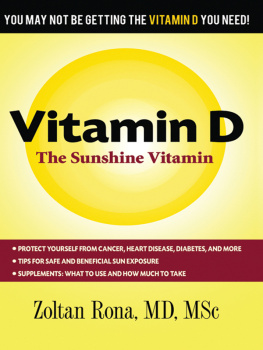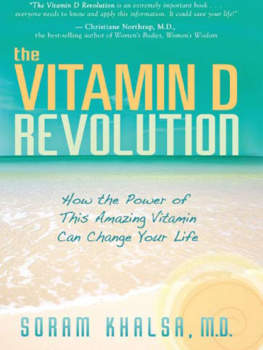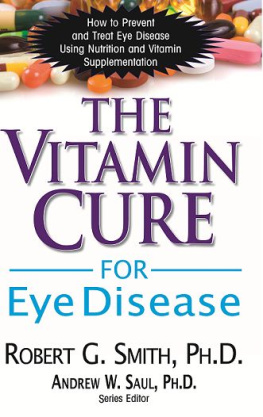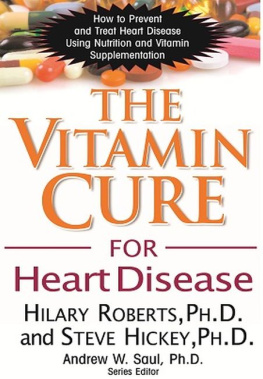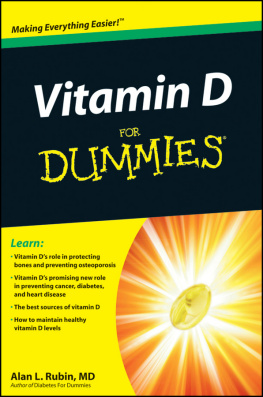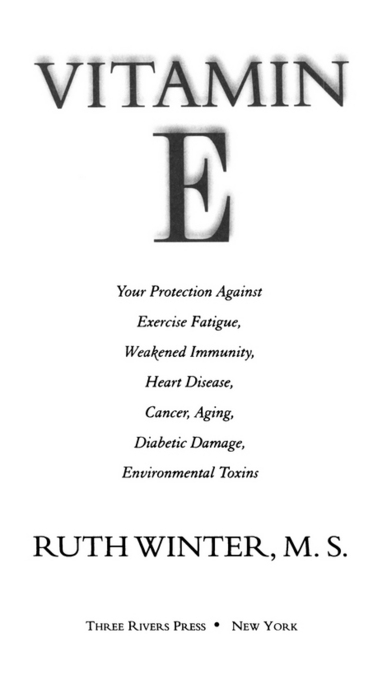Also by the Author
The Anti-Aging Hormones
Super Soy
A Consumers Guide to Medicines in Food
A Consumers Dictionary of Medicines
A Consumers Dictionary of Cosmetics Ingredients
A Consumers Dictionary of Food Additives
A Consumers Dictionary of Household, Yard, and Office Chemicals
Poisons in Your Food
Ageless Aging
Cancer-Causing Agents
How to Reduce Your Medical Bills
Copyright 1998 by Ruth Winter
All rights reserved. No part of this book may be reproduced or transmitted in any form or by any means, electronic or mechanical, including photocopying, recording, or by any information storage and retrieval system, without permission in writing from the publisher.
Published by Three Rivers Press, a division of Crown Publishers, Inc., 201 East 50th Street, New York, New York 10022. Member of the Crown Publishing Group.
Random House, Inc. New York, Toronto, London, Sydney, Auckland
http://www.randomhouse.com/
THREE RIVERS PRESS and colophon are trademarks of Crown Publishers, Inc.
Library of Congress Cataloging-in-Publication Data
Winter, Ruth, 1930
Vitamin E: your protection against exercise fatigue, weakened immunity, heart disease, cancer, aging, diabetic damage, environmental toxins / by Ruth Winter
p. cm.
1. Vitamin EPhysiological effect. 2. Vitamin ETherapeutic use. I. Title.
QP772.T6W54 1998
612.399dc21 97-15955
eISBN: 978-0-307-82936-8
v3.1
CONTENTS
Introduction
Vitamin E, Your Great Protector
The Discovery
The Shady Lady Fights Your Free Radicals
Vitamin E and Your Blood
Vitamin E and Your Heart
Vitamin E and Cancer
Vitamin E and Muscle Power
Vitamin E and Your Lungs
Vitamin E and Your Skin
Vitamin E, Sex, and Fertility
Vitamin E Against Aging
How Much Vitamin E Do You Need?
Vitamin E in Raw, Processed, and Cooked Food
Appendix I
Good Sources of Vitamin E
Appendix II
Vitamin E Content of Foods
Appendix III
Vitamin E in Edible Portions of Food
INTRODUCTION
V ITAMIN E, Y OUR G REAT P ROTECTOR
Vitamin Es history has been fraught with promise and despair. It has never achieved the acceptance of its cousins A, B, C, and D. For more than half a century after its discovery, it remained an enigmathe center of an intriguing scientific controversy.
Naysayers claimed that a vitamin E deficiency disease had not been proven in humans, and treatment with vitamin E was worthless. They called it the shady lady of nutrition or the vitamin in search of a disease.
The U.S. Food and Drug Administration for years officially denied vitamin E had any therapeutic value. Yet the FDA official who once read me a statement to that effect, when asked afterward, What do you really think about it? admitted to me that he took vitamin E each day before jogging.
The shady lady has at last become highly respectable. Scientific evidence concerning vitamin Es many benefits is rapidly developing.
The results of recent epidemiological studies have heralded the benefits of vitamin E and other antioxidant nutrients. For example:
- Nutrition intervention trials in Linxian County, China, associated a reduced risk of several types of cancer, especially stomach cancer, with dietary supplements of vitamin E, beta-carotene, and selenium.
- Studies show that the risk of cataract may be reduced by 40 to 50 percent with dietary supplements of vitamin E and vitamin C.
Vitamin E is, according to the latest scientific reports, one of the most effective preventative substances against heart disease, cancer, and some of the disabilities associated with aging. In fact, the president of the American Heart Association in 1996 declared vitamin E one of the biggest advances in cardiology. Cancer specialists and neurologists are issuing report after report that vitamin E is effective in warding off some malignancies and nerve damage.
Why did it take so long for recognition of the value of this vitamin? Even before the positive results from recent major studies, physicians and other intelligent individuals began swallowing their doses of vitamin E. They began to believe that what the food faddists and health nuts have been saying all along may be absolutely truevitamin E is of great benefit to the human body and, in medicinal doses, may help prevent and treat many of our major physical ailments.
Is vitamin E necessary to your health? This book is an attempt to inform you about the fascinating history and current scientific excitement about vitamin E, the inexpensive, formerly unappreciated, vital vitamin.
1
T HE D ISCOVERY
Why did female rats given a diet of rancid lard conceive young in a normal manner but fail to carry to term? What was it in lettuce that could correct the fertility problem? The year was 1922, and two young American scientists, Dr. Herbert M. Evans and Dr. Katherine S. Bishop, wanted to find out. Their aim was to determine whether reproduction was dependent on some nutritive substance different from those which produced growth and adulthood.
At first, Drs. Evans and Bishop thought that the vitamin C in lettuce cured the rat mothers problem, but then they determined only the oil of the vegetable worked. To their amazement, they then discovered that wheat also cured the infertility.
Intrigued, Dr. Evans went to a nearby flour mill and saw three great streams flowing from the milling of wheat berry; the first constituted the outer cover or chaff; the second, the endospermthe white so-called flour; and the third, which came in flattened flakes, stuck into such units by its oil contentthe germ.
Dr. Evans found that single daily drops of the golden yellow wheat germ oil proved remedial.
The substance in the lettuce oil and the wheat germ was vitamin E.
To obtain a proper scientific name for their discovery, Dr. Evans consulted George Calhoun, a professor of Greek at the University of California at Berkeley.
What does the substance do? Calhoun asked.
It permits animals to bear offspring, Evans replied.
So Calhoun took tokos, the Greek word for childbirth, and the Greek verb pherein, meaning to bring forth, and the suffix ol for alcohol; thus vitamin E was named tocopherol.
It is now accepted that there are four tocopherols and four closely related compounds, tocotrienols, in the E family. Tocopherols are widespread in nature. They are in almost all plants and animals so far examined. The most active of them found so far is alpha tocopherol. All the tocopherols have been synthesized and are readily available. The different forms of vitamin E have unique stability and biochemical activity. They may vary in their potency and their potential benefit.
Vitamin E is fat solubleit dissolves in fat, but not in water. It is highly concentrated in the adrenal glands, found above the kidney. The adrenals regulate sodium and potassium in the blood, produce certain sex hormones, and help the body respond to stress.



